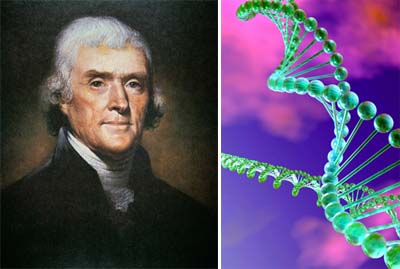Dec 18, 2025
Dec 18, 2025
 Recently, US President (& Author of Declaration of Independence of United States) Thomas Jefferson's paternity of his slave Sally Fleming's children has been in news. For nearly 200 years, since US president Thomas Jefferson's time, many traditionalists maintained that Jefferson did not cohabit with Sally. But some descendents of Sally maintained otherwise and claimed to be progeny of the ex-president. This old historical controversy has now been resolved using modern genetic DNA analysis methods (Reference - Founding father by Eric S Lander & Joseph J Ellis and Foster et al, Nature | Volume 396 | 5 November 1998 | pages 14, 27-28).
Recently, US President (& Author of Declaration of Independence of United States) Thomas Jefferson's paternity of his slave Sally Fleming's children has been in news. For nearly 200 years, since US president Thomas Jefferson's time, many traditionalists maintained that Jefferson did not cohabit with Sally. But some descendents of Sally maintained otherwise and claimed to be progeny of the ex-president. This old historical controversy has now been resolved using modern genetic DNA analysis methods (Reference - Founding father by Eric S Lander & Joseph J Ellis and Foster et al, Nature | Volume 396 | 5 November 1998 | pages 14, 27-28).
The genetic DNA study of descendents of Jefferson family and Sally Fleming's family, has confirmed with very high probability that, US President Thomas Jefferson was indeed the father of at least one of the sons of Sally Fleming.
How was this genetic work done? Geneticists used a scientific fact, that most of the male Y-chromosome is passed intact from father to son. Females do not carry the Y-chromosome. With modern advances in genetics, this fact has been used to trace paternal lineage, and resolve stories like Thomas Jefferson's.
Thomas Jefferson did not have surviving sons from his legal wife. But his paternal uncle's male lineage is in tact to present time. The genetic Y-chromosome of these persons (eight generations down from Thomas Jefferson's paternal uncle) living at present time was used as the reference. This was compared with intact male line persons from (Five generations down from) Sally Fleming living presently. The geneticists used polymorphic markers so that Y-chromosome can be distinguished by haplotypes. They found that Sally Fleming's son Eston's male line progeny had same haplotypes as Field Jefferson who was paternal uncle of Thomas Jefferson. Using other physical and living proximity factors, the geneticists have concluded with high probability that Eston Fleming was the son of Thomas Jefferson and Sally Fleming.
This class of human male lineage research is now very active and is being conducted in native populations of Wales, England, in Iceland and to establish uniqueness, paternity, historical lineage, medical issues and intellectual issues of heredity etc amongst various population groups.
Does this not ring a bell amongst traditional Hindus who believe in 'gothra' identification carried down from Sanathana-dharma orthodoxy?.
'Gothra' is an identity carried by male lineage in India from time immemorial. Most people have gothra chain names traceable to Rig Vedic Rishis like 'Gowthama', 'Vasishta' 'Viswamithra' and to first sons of Vaivaswatha Manu like Angirasa & Bhrigu. Purana such as Vishnu Purana refer to individual identity through 'Gothra'. Listings of more than 250 Gothra chains have been explicitly listed. I have heard of instances of Muslims converted from Hinduism still keeping track of their 'Gothra'.
For example we know that Buddha, named Siddhartha was of 'Gowthama Gothra'. It means that his Y-chromosomes were probably from Rig-Vedic Rishi 'Gowthama Rahoogana'.
How did the people of 3000-4000 years ago realize that genetically there was transference of some unique characteristics only from father to son (in the form of Y-chromosomes)? In recent past when it was fashionable to condemn all Indian traditional systems as of no value, non-believers have referred to 'Gothra' as archaic, unscientific, irrelevant and male chauvinistic!
Modern DNA & genetic research has confirmed male line Y-chromosomal transference, through 8 generations in case of Thomas Jefferson. 'Gothra' in essence really stands for Y-chromosomal identity.
Nearly 2500 years have passed since death of Buddha, but many 'Gowthama Gothra' individuals exist now also. They can claim genetic relation to Buddha. Typically 4 generations occur in 100 years and in 2500 years nearly 100 generations are complete. Other 'Gothra' chains may have run 100-200 generations from Vedic period if male lineage did continue unbroken. Do Y-chromosomes remain intact after, say 100 generations of unbroken male issues? Genetic mutations may or may not have changed some Y-chromosomes.
This appears to be a very interesting field of research for future to see if persons of same 'Gothra' in the present generations have common and unique Y-chromosomal features.
15-May-2000
More by : Dr. S. Balakrishna

|
There is a saying in Sanskrit;atmaawai putra namaasi.This means that father is reborn as son,a clear reference to the y-chromosome theory. prakasam |

|
The era of Adi Shankaracharya is wrongly mentioned as 483 BC whereas the authentic version as per Sri Madhaveeya Shankara Vijayam says it is around 820 AD. |

|
Siddhartha Buddha (1887-1807 BC) was son of Shuddhodana of Ikshvaku dynasty 60 generations after Rama and 25 generations after Brihadbala who was killed by Abhimanyu in Mahabharata war on 25-10-3139 BC. After, enlightment, Siddhartha became Buddha, but never became Gautama. Gautama Buddha was born in 563 BC and his followers were vehement in capturing Vedic temples and making them Buddhist. This has been indicated in all Bauddha texts particularly Stupa-vamsha listing 28 Buddhas. That created counter defense in period of Sriharsha Vikramaditya (his shaka in 456 BC) and setting up 4 Pithas of Shankaracharya in 483 BC taken as death of Gautama Buddha. Vishnu incarnation Buddha was son of Ajina Brahmana of Magadha who performed a yajna at mount Abu in 756 BC (Shudraka shaka) when a federation of 4 agni-vamshi kings was formed under king Shudraka of Malava. |